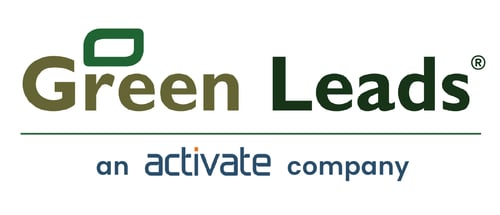Wouldn’t it be great to find accounts that suit your company best? We often talk a lot about the customer finding a fit, but what if we took a look at the company finding their fit too?
Account-Based Marketing (ABM) provides an opportunity to find tailored customers that fit your product or service. Businesses often choose the ABM approach in order to account for a buying group of people. This is often done in the B2B space because these buyers often have multiple considerations throughout the buying journey. We’ll break down the practices of the B2B buyer’s journey and the buying group that are essential to ABM strategy.
Furthermore, with ABM you can work to build high-value accounts that align with your mission and suit your growth trajectory. In this article we pulled together the 5 best tactics to get you started with ABM.
|
Green Leads On: Account-Based Marketing 101
|
What is ABM?
ABM is a strategy used to target specific accounts that align with your company’s goals. It also incorporates accounts that show potential for expansion with the right approach. Many organizations utilize their marketing and sales teams to research and target accounts that would benefit from a tailored approach.
This is an extremely pertinent topic given the fast-paced nature of the digital age. It’s become harder and harder for companies to get in front of their customers to capture their interest. Instead of generating a lead based on any data, ABM poses that you research to find high-value accounts that align with your product/service offerings.
How Does ABM Work?
Personalization drives much of ABM mainly because the intended account is highly specialized to meet certain criteria. Often when you start with an account you have to spend the time figuring out what works best for them.
ABM provides a targeted approach to handling accounts and customers. You’re basically figuring out what aligns so well with your products/services that it becomes such a high ROI. As mentioned above, there are multiple people involved in a B2B buy, with it becoming more complex the larger the target account is. In an ABM strategy, these people are identified by role, title, and name. Then the marketers surround them with digital content (sometimes physical content such as swag) to gain recognition, educate, engage, and persuade. Below is a list of a typical buying group, which may differ depending on size.
- Decision Makers
- Influencers
- Evaluators
- User Group
- Budget Approver
Account-Based Marketing vs. Lead Generation
Think of ABM as a focused outbound strategy that has specific qualifications to adhere to. Your ABM approach is narrow and targeting a specific customer or market. Lead generation is a much wider strategy that involves casting a large net to pull in as many prospects as you can. However, lead generation can become a bit overwhelming if you keep catching unqualified leads. Sure, you could always find an exact fit, but oftentimes when you’re casting out to a wide network, you have to put some work into sifting through the possibilities.
.png?width=226&name=GREEN%20LEADS%20(2).png)
ABM is great for weeding out who doesn’t align before going to the effort of seeking out customers. You can focus on your objectives and tailor offerings based on who you are trying to reach.
These are merely two types of strategies to implement, but it’s important to define what works best for you. If you’re looking for traction and to see your options, lead generation might be the better option. But if you’re looking for personalized, tailored accounts then ABM could be the better choice in that instance.
Account-Based Marketing Examples
The great thing about MCM is that in practice it’s actually quite intuitive and replicable across industries. For example, direct mail has become a popular method again to reach targeted customers. Perhaps this has something to do with the abundance of less than personal emails that no longer work for certain customers.
However, on the flip side a well crafted, personalized email campaign could be extremely effective. You could also create a webinar that can be viewed at different times to engage with specific accounts on industry/specific updates or just to check in. It all depends on your approach and account. A lot of this is driven by data, which makes research that much more effective for targeting specific accounts.

Benefits of Account-Based Marketing
If you’re a B2B company looking to target specific, worthwhile accounts, ABM is probably a good place to start. Below we’ve outlined some benefits of choosing ABM.
Improve Customer Experience
Personalization is the way of the future. Everyone wants the ability to curate an experience that is tailored to their exact preferences. Where other tactics employ a wide variety of tools, ABM simplifies and targets what an account actually needs. This way you can engage with your account/customer to figure out what they are looking for.
Think about creating engaging copy that both educates and entertains while offering your product/service. Experience has become the tried and true test for many brands as they grow.
Optimize Marketing & Sales Funnel
No one likes a slow moving silo. In fact, many are moving away from the segmented approach that was housing different departments in completely separate ways. Thanks to an increase in data offerings, we can now take cross-functional approaches to previously segmented departments.
Now the marketing and sales funnel opens up simply because you targeted your account rather than putting feelers out for anyone to use. ABM is certainly not the only choice for your organization. There are additional inbound and outbound marketing tools to consider.
Increase Sale Speed Cycle
Your sales cycle is largely dependent on the ability to automate tasks, execute actionable goals, and focus on data-driven performance. You can increase your sales by paying attention to the customer profiles you have built.
Let’s say you want to speed up your process, well, before you can jump in to fix something it’s probably best to figure out the “why” behind it. You can figure out pain points for customers and weed out unnecessary processes that hinder the end result. A lot of this goes back to the targeted approach of marketing rather than casting a wider net.
Improve ROI
Your ROI is largely determined by your account and eventual future customer base. You should strive to build brand awareness and loyalty as you scale. Many companies scale very fast but forget the importance of identifying their target audience.
ABM tactics are direct and tailored so this supports long-term relationships and brand trust. Your ROI will also depend on how you communicate with your account’s leadership team. It’s best to give regular updates on performance and foster new ideas for growth. Building a case study to show account teams is a great way to foster trust and generate ideas and practices for the future.
Challenges of Account-Based Marketing
Using ABM does come with its own challenges, many of which boil down to growing pains of trying a new technique. It’s something to keep in mind before starting your process.
ABM can be time consuming and expensive -
Because it is so targeted, ABM does take some time to set up before you can start receiving tailored account matches. You may have to put a lot of work into planning before you even get to the next stage of the account process. The time to execute may require a sustained effort and budget as it often takes longer than your typical quarterly campaign. But this is also a great point to perfect your systems and plans before rolling out marketing/sales efforts. You should also consider your cost as it is often expensive to execute a complete ABM plan. Newly acquired accounts should be of high lifetime value to ensure that you are getting out all that you are putting in. Take the time to plan, build, and then execute based on the data you collect.
ABM requires a sync effort
While you don’t have to be in complete unison all the time, your teams need to be on the same page. With ABM you have to sync your marketing and sales teams to a high degree, but you also want them to still do their jobs effectively. There may be some growing pains, but your efforts toward organization and streamlining tasks will surely pay off in the long run.

5 Account-Based Marketing Strategies
-
Plan/Build Systems - It sounds simple enough to strategize, plan, and build the right systems to support ABM practices. It’s never that easy though. That’s why we recommend really sitting down to plan out your account strategy from idea to implementation. Walk through the customer journey and build out your customer profile. All of these exercises reinforce your data while also formalizing the necessary processes that will follow.
-
Identify Accounts - This is where your quantitative and qualitative research skills come in handy. Before you even reach out to a potential account you should completely understand why they fit based on your specified criteria. You can include location factors and certain industry types in the selection.
-
Increase Engagement - As mentioned earlier, engagement is huge when looking at long-term goals. You can keep your account for longer by crafting engaging content and communicating with your customers on a regular basis. This is actually a great way to build brand trust over time too.
-
Streamline Marketing and Sales - ABM relied heavily on best communication practices to ease transition periods. If you’re looking to acquire a potential lead, you must organize your marketing and sales efforts to reflect that. The two departments often become intertwined as they generate and then sell to those leads.
-
Stay Updated and Network - If you’re looking to get in front of accounts that you know are a perfect fit, then you should stay apprised on industry trends and events. Try to post in industry journals or newsletters. Better yet, use those targeted ads in places you know your account is probably looking. The key is to remember the goal is a targeted approach to generating leads.
![]()
Final Thoughts: Is ABM for Me?
ABM is not right for every business. First you should identify if you’re looking to cast a wide net to generate leads, or if you want to be more targeted in the approach. The targeted approach is within the wheelhouse of ABM. It’s probably a better choice for those looking to build out detailed customer profiles and tailor their products/services to an account.
However you look at your approach, we can all agree that a streamlined effort is the way to go. At Green Leads we love getting discovery calls to figure out how best to serve your needs. Schedule a call with us today to talk Account-Based Marketing tactics or any other of our pipeline solutions.
In the meantime, head over to our Podcasts and listen to our team talk all things pipeline generation and much more.




